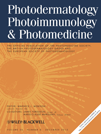Urocanic acid suppresses induction of immunity in human skin
Conflicts of interest: G. N. M. was employed by the Cosmetic, Fragrance, and Toiletry Association, which sponsored the study.
Abstract
Background/Purpose: Trans-urocanic acid is isomerized to cis-urocanic acid (C-UCA) by ultraviolet radiation. C-UCA suppresses immunity in vitro and in vivo in animals; its effect on human skin is unknown. We sought to determine whether its topical application to normal skin suppresses induction of immunity to dinitrochlorobenzene (DNCB).
Methods: Forty subjects applied C-UCA (0%, 0.02%, 0.2%, or 2%) for 17 days. A 40-mcg dose of DNCB was then applied to induce immunity. Subjects were challenged for immunity at 6-week follow-up by occluding doses of DNCB (0, 3.125, 6.25, or 12.5 mcg) on untreated normal skin. Induced immunity was measured by area of erythema and induration 2 and 4 days postchallenge.
Results: No significant differences were found in incidence of sensitization by C-UCA concentration (P=.59). DNCB sensitization developed in all 10 subjects induced through 0% C-UCA (placebo); only 23 of 30 patients were sensitized through skin treated with C-UCA. Mean areas of erythema and induration induced through C-UCA-treated skin were less than those in controls (P<0.05). The number of Langerhans cells in C-UCA-treated skin was unaffected. Laboratory tests of immune function and lymphocyte numbers were unchanged.
Conclusion: Topically applied C-UCA blunts normal induction responses to a cutaneous sensitizer.




